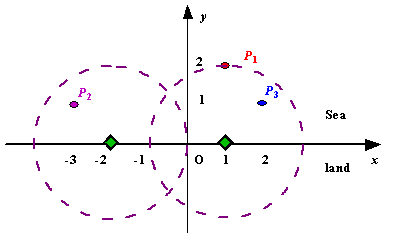Description
Assume the coasting is an infinite straight line. Land is in one side of coasting, sea in the other. Each small island is a point locating in the sea side. And any radar installation, locating on the coasting, can only cover d distance, so an island in the sea can be covered by a radius installation, if the distance between them is at most d.
We use Cartesian coordinate system, defining the coasting is the x-axis. The sea side is above x-axis, and the land side below. Given the position of each island in the sea, and given the distance of the coverage of the radar installation, your task is to write a program to find the minimal number of radar installations to cover all the islands. Note that the position of an island is represented by its x-y coordinates.

Figure A Sample Input of Radar Installations
We use Cartesian coordinate system, defining the coasting is the x-axis. The sea side is above x-axis, and the land side below. Given the position of each island in the sea, and given the distance of the coverage of the radar installation, your task is to write a program to find the minimal number of radar installations to cover all the islands. Note that the position of an island is represented by its x-y coordinates.

Figure A Sample Input of Radar Installations
Input
The input consists of several test cases. The first line of each case contains two integers n (1<=n<=1000) and d, where n is the number of islands in the sea and d is the distance of coverage of the radar installation. This is followed by n lines each containing two integers representing the coordinate of the position of each island. Then a blank line follows to separate the cases.
The input is terminated by a line containing pair of zeros
The input is terminated by a line containing pair of zeros
Output
For each test case output one line consisting of the test case number followed by the minimal number of radar installations needed. "-1" installation means no solution for that case.
Sample Input
3 2 1 2 -3 1 2 1 1 2 0 2 0 0
Sample Output
Case 1: 2 Case 2: 1
题意:X轴表示海岸线,在X轴上方是海 ,下方是陆地 ,海上有n个小岛,现在要在海岸线上安装雷达,
雷达的覆盖范围是一个以雷达为圆心,以d为半径的圆,请用最少的雷达覆盖所有的小岛;
当无法覆盖时输出-1
思路:算出 每个小岛能被覆盖的雷达的圆心范围,即以小岛为圆心 d为半径 作圆,该圆与X轴的交点:
左交点为x-sqrt(d*d-y*y);
右交点为x+sqrt(d*d-y*y);
按照 左交点 从小到大排序,第一个雷达放在第一个点的右交点,
如果某点的左交点在当前雷达的右边,则需安装一个新雷达,更新雷达的位置
否则 如果 某点的右交点也在当前雷达的左边,则把当前雷达的圆心更新为该点的右交点;
贪心思想,开始wrong了好多遍,同样的思路,网上解题报告代码一遍就AC,始终想不明白,突然发现 记录雷达的坐标定义成了 int型,改了就A了,以后得细心、、、
AC代码:
#include<cstdio>
#include<algorithm>
#include<cmath>
using namespace std;
struct stu
{
double x,y,l,r;
};
int cmp(struct stu a,struct stu b)
{
return a.l<b.l;
}
int main()
{
int i,j,n,d,m,t;
double k;
struct stu s[1005];
for(i=1;;i++){
scanf("%d%d",&n,&d);
t=1;
if(n==0&&d==0)
break;
for(j=0;j<n;j++){
scanf("%lf%lf",&s[j].x,&s[j].y);
s[j].l=s[j].x-sqrt(d*d-s[j].y*s[j].y);
s[j].r=s[j].x+sqrt(d*d-s[j].y*s[j].y);
if(s[j].y>d||d<=0)
t=0;
}
if(t==0){
printf("Case %d: -1\n",i);
continue;
}
sort(s,s+n,cmp);
k=s[0].r;
m=1;
for(j=1;j<n;j++){
if(s[j].l>k){
m++;
k=s[j].r;
}
else if(s[j].r<k)
k=s[j].r;
}
printf("Case %d: %d\n",i,m);
}
return 0;
}





 本文介绍了一个经典的算法问题——如何使用最少数量的雷达装置覆盖海上的所有小岛。通过计算每个小岛可以被雷达覆盖的范围,并采用贪心算法确定雷达的最佳放置位置。
本文介绍了一个经典的算法问题——如何使用最少数量的雷达装置覆盖海上的所有小岛。通过计算每个小岛可以被雷达覆盖的范围,并采用贪心算法确定雷达的最佳放置位置。
















 1778
1778

 被折叠的 条评论
为什么被折叠?
被折叠的 条评论
为什么被折叠?








